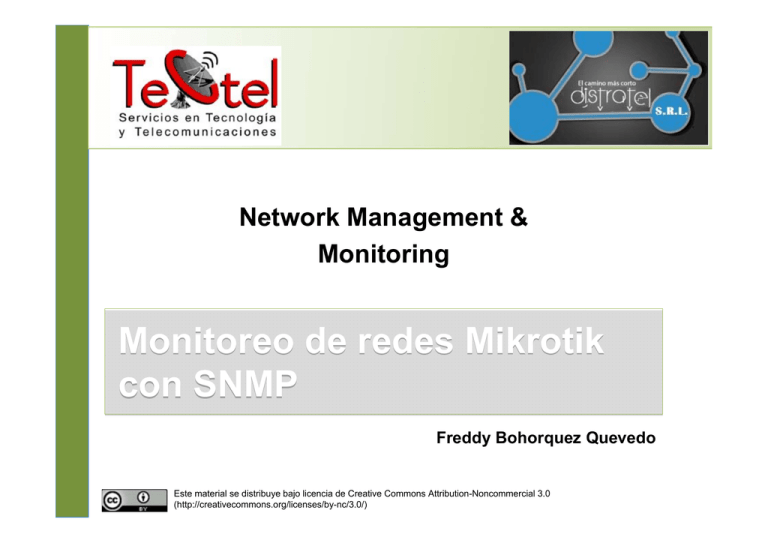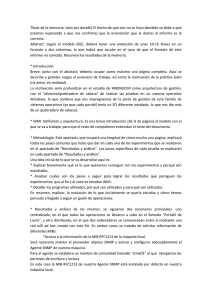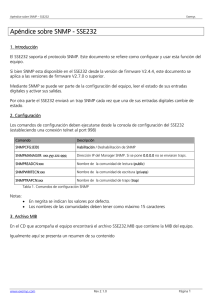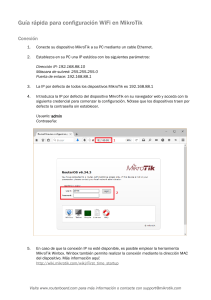Monitoreo de redes Mikrotik con SNMP Monitoreo de redes
Anuncio

Network Management &
Monitoring
Monitoreo de redes Mikrotik
con SNMP
Freddy Bohorquez Quevedo
Este material se distribuye bajo licencia de Creative Commons Attribution-Noncommercial 3.0
(http://creativecommons.org/licenses/by-nc/3.0/)
Sobre TecTel Bolivia
Orígenes en Redes Inalámbricas Comunitarias
2004. Conectividad Rural e ISP Comunitarios
Primeras Instalaciones basadas en WRAP
Despliegue de Redes PtP y PtMP
2005. Encuentro con Mikrotik RB y ROS
2009. Inicio de Tectel como empresa
especializada en Tecnología y
Telecomunicaciones
• 2010. Distribuidor oficial de Mikrotik
• 2014 se crea DISTRATEL, incorporando
soluciones en control y automatización.
•
•
•
•
•
•
Contenido
•
•
•
•
•
•
Qué es SNMP?
Cómo funciona SNMP?
OIDs y MIBs
Polling, querying and Traps
SNMP en Mikrotik
Caso de Uso en Cacti
Qué es SNMP?
SNMP – Simple Network Management Protocol
– Estándar abierto — existen cientos de herramientas
para explotarla.
– Presente en cualquier equipo de red mínimamente
decente.
SNMP usa la arquitectura manager/agent.
Qué es SNMP?
Protocolo UDP, port 161, 162
Versiones:
– V1 (1988) – RFC1155, RFC1156, RFC1157
• Especificaciones Iniciales originales
– v2 – RFC1901 ... RFC1908 + RFC2578
• Mejoras a v1, tipos de datos nuevos, GETBULK
– v3 – RFC3411 ... RFC3418
• seguridad y encriptación
Cómo funciona SNMP?
Comandos básicos o primitivas
– GET (manager -> agent)
– GET-NEXT (manager -> agent)
– GET-RESPONSE (agent -> manager)
– SET (manager -> agent)
– TRAP (agent -> manager)
MIB:
Base de Información de Administración
• MIB, colección de información que está
organizada jerárquicamente, incluye:
– Identificador del Objeto (OID)
– Nombre del Objecto
– Descripción del Objecto
– Tipo de Dato (integer, text, list)
• MIB se describe usando ASN.1
• MIB estandar incluye:
– MIB-II – (RFC1213) – a group of sub-MIBs
– HOST-RESOURCES-MIB (RFC2790)
MIB Tree
root
iso(1)
ccitt(0)
joint-iso-ccitt(3)
org(3)
dod(6)
ciscoMgmt(9)
1.3.6.1
ciscoEnvMonObjects(1)
internet(1)
directory(1) mgmt(2) experimental(3)
mib-2(1)
system(1)
interfaces(2)
private(4)
enterprises(1)
snmp(11)
ip(4)
ciscoEnvMonMIB(13)
cisco(9)
ciscoEnvMonTemperatureStatusTable(3)
ciscoEnvMonTemperatureStatusEntry(1)
ciscoEnvMonTemperatureStatusValue(3)
...
Obtención de Información
NODO
ADMINISTRADO
ESTACIÓN
ADMINISTRADORA
UDP 161
?
L
MIB
UDP 161
AGENTE
Consulta/Solicitud de variable:
?
L
9 GET REQUEST
9 GET NEXT REQUEST
9 GET BULK (SNMP v.2)
Respuesta a solicitud:
9 GET RESPONSE
Modificación de Información
NODO
ADMINISTRADO
ESTACIÓN
ADMINISTRADORA
UDP 161
L
!
UDP 161
AGENTE
Modificación de valor de variable:
!
L
9 SET REQUEST
9 SET NEXT REQUEST
Respuesta a solicitud:
9 GET RESPONSE
EJEMPLO:
EJEMPLO Se puede usar para resetear el valor de los
contadores, como el número de paquetes procesados.
Traps - Interrupciones
NODO
ADMINISTRADO
ESTACIÓN
ADMINISTRADORA
UDP 162
MIB
1
AGENTE
1
Un Agente informa de un evento:
9 TRAP
EJEMPLO:
EJEMPLO El Agente de un router
informa de que un enlace ha caído.
SNMP en Mikrotik
Management information base (MIB)
Puede descargarse de
http://mikrotik.com/download/Mikrotik.mib
Object identifiers (OID)
[admin@Mikrotik]
uptime:
total-memory:
used-memory:
cpu-frequency:
build-time:
[admin@Mikrotik]
> /system resource print oid
.1.3.6.1.2.1.1.3.0
.1.3.6.1.2.1.25.2.3.1.5.65536
.1.3.6.1.2.1.25.2.3.1.6.65536
.1.3.6.1.4.1.14988.1.1.3.14.0
.1.3.6.1.4.1.14988.1.1.7.6.0
>
SNMP en Mikrotik
Object identifiers (OID)
root@debian:~# snmpwalk -v 1 -c freddybq -On 192.168.14.126 | more
.1.3.6.1.2.1.1.1.0 = STRING: "RouterOS RB751U-2HnD"
.1.3.6.1.2.1.1.2.0 = OID: .1.3.6.1.4.1.14988.1
.1.3.6.1.2.1.1.3.0 = Timeticks: (8310000) 23:05:00.00
.1.3.6.1.2.1.1.4.0 = STRING: "fbq"
.1.3.6.1.2.1.1.5.0 = STRING: "MikroTik"
.1.3.6.1.2.1.1.6.0 = STRING: "tectel"
.1.3.6.1.2.1.1.7.0 = INTEGER: 78
.1.3.6.1.2.1.2.1.0 = INTEGER: 8
CACTI
• Herramienta para sensar (poolling),
almacenar y presentar estadísticas de red y
sistemas.
• Está diseñada en base a RRDTool, con
especial énfasis en la interfaz gráfica
• Casi todas las funcionalidades pueden
configurarse a través de interface web.
CACTI
CACTI - Interface
Polling
CACTI - Plugins
CACTI - Trap
CACTI - snmp-query
<interface>
<name>Mikrotik - Get signal strength</name>
<description>Get signal strength</description>
<index_order>signalStrengthIndex</index_order>
<index_order_type>alphabetic</index_order_type>
<oid_index>.1.3.6.1.4.1.14988.1.1.1.2.1.1</oid_index>
<oid_index_parse>OID/REGEXP:^.{30}(.*)</oid_index_parse>
<fields>
<signalStrengthIndex>
<name>Index</name>
<source>index</source>
<direction>input</direction>
</signalStrengthIndex>
<signalStrengthDevice>
<name>Device</name>
<method>get</method>
<source>value</source>
<direction>input</direction>
<oid>.1.3.6.1.4.1.14988.1.1.1.2.1.1</oid>
</signalStrengthDevice>
<signalStrengthValue>
<name>Value</name>
<method>get</method>
<source>value</source>
<direction>output</direction>
<oid>.1.3.6.1.4.1.14988.1.1.1.2.1.3</oid>
</signalStrengthValue>
</fields>
</interface>
CACTI - Mikrotik Nivel de señal
Referencias
• Essential SNMP (O’Reilly Books) Douglas Mauro, Kevin Schmi
• Wikipedia:
http://es.wikipedia.org/wiki/Simple_Network_Management_Protocol
• SNMP: http://informatica.uv.es/iiguia/R/apuntes/snmp.ppt. Rogelio
Montañana, Universidad de Valencia, Departamento de Informática
• SNMP Link – collection of SNMP resources
http://www.snmplink.org/
• Net-SNMP Open Source SNMP tools
http://net-snmp.sourceforge.net/
• Cacti and Mikrotik - How to graph signal strength without hassle: Cacti and
Mikrotik - How to graph signal strength without hassle
• Manual SNMP Mikrotik: http://wiki.mikrotik.com/wiki/Manual:SNMP
• Integration with Nagios http://www.cisl.ucar.edu/nets/tools/nagios/SNMPtraps.html



